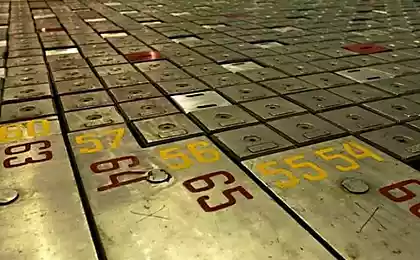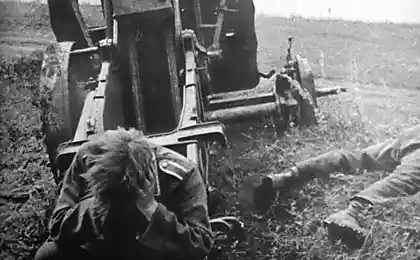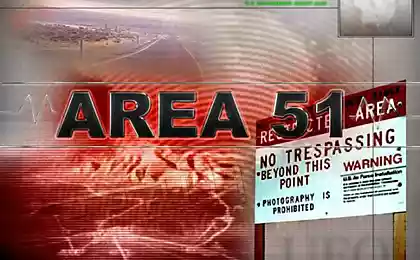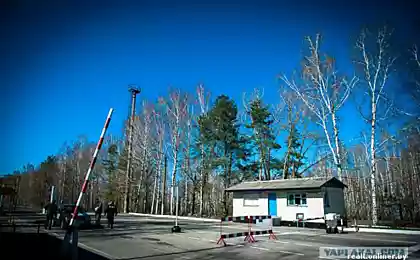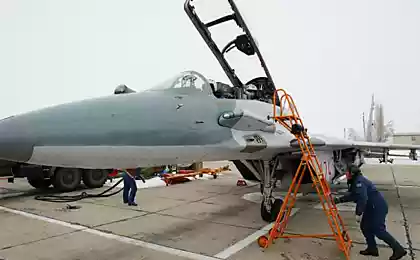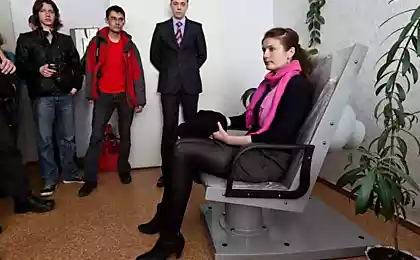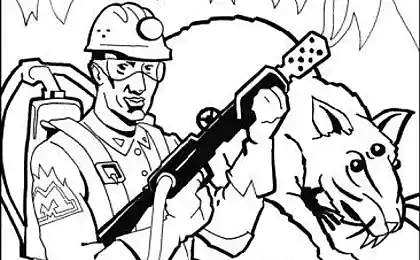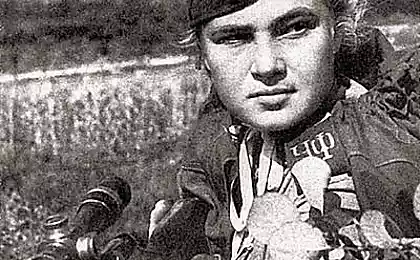614
Kursk
As the last German offensive failed
Continuing the theme of Kursk. 50 days of hell
Exactly 70 years ago on July 15, 1943, the Soviet Information Bureau reported early onset of the country near Orel and Belgorod. So the country learned that the battle that the meager reports described as "our troops in the Belgorod and Orel-Kursk sector repulsed the enemy's attack," ended in favor of the Red Army.
The text under the cut
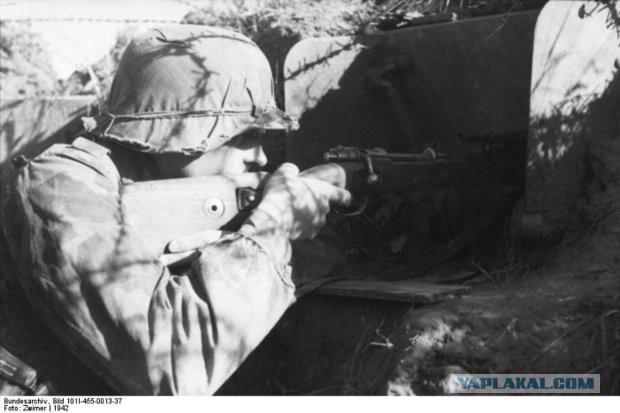
The battle at the Kursk Salient was always in the shadow of the Battle of Stalingrad. She never called a radical change in the Great Patriotic War and the movies filmed on the subject is not so much as, for example, about the battle for the Dnieper.
This is the battle of Kursk was the last attempt to win the German Army. After a July 1943 speech on how to achieve favorable world is not going.
Also fighting on the Black Earth was a mirror image of the summer of 1941 the situation of the first months of the war almost repeated itself on a relatively small area. That's just the battle was just the opposite.
Unwanted offensive
The end of the spring of 1943 proved to be a failure of the Soviet army. The rapid offensive launched after the Stalingrad battle stopped. The Germans caught their breath, recaptured Kharkov, Belgorod occupied, and to the north of the Eagle still holds the position of just 280 km from Moscow. At the same time in Berlin, we developed the operation "Citadel" - offensive to encircle the Soviet forces in the Kursk area, depriving the Red Army the most combat-ready units, and then start a new offensive in the east.
The basic rate in the preparation of "Citadel" was made on surprise, but she was not there originally. Military generals assured Hitler that the attack should be in May, but the head of Nazi Germany did not want to risk it. He hoped to July, the military industry to supply a sufficient amount of new heavy equipment - tanks "Tiger" and "Panther" and self-propelled guns "Ferdinand».
Among the generals there was no consensus on the plan of attack. For example, set aside after the Battle of Moscow Heinz Guderian insisted that the attack of the German army, and did not need to. According to him, much more effective tactic was pooping the Soviet army counter-effective. The fact that the Red Army generals will try to advance to liberate its territory H.Guderian no doubt.
Skeptical of the generals and the very idea of the attack on Kursk. Erich von Manstein, for example, doubted that surrounded Soviet units will be able to successfully keep the boiler.
It is noteworthy that the Soviet army abandoned plans to attack, fearing a repeat of the defeat at Kharkov summer of 1942. At the same time in the spring of 1943 the Soviet command came to the conclusion that the Germans try to attack the Kursk. The construction of fortifications. The pace of their construction depended on the outcome of future battles.
Unexpected start
German historians still believe that they have lost the battle because of "Stirlitz" - agent "Werther" in his own General Staff, who said in Moscow that the offensive would begin on July 3-6. That is explained by the fact that the German generals knew the date of occurrence of Adolf Hitler on July 1 and the rate of the Soviet command - July 2.
Was there a "Werther" in fact - it is not known so far. However, starting from July 3 Soviet army waited for the offensive, July 4 captured prisoner told me that the Germans will attack at 5:30 am Moscow time on July 5.
The Germans were pretty surprised by the fact that the Soviet army was ready to attack them. It was really a lot of surprises. As it turned out, the Nazi generals were preparing for an attack based on the realities of 1941, but now everything has changed. On the border waiting for the massive projection of defense, in the actions of the Soviet commanders there was no panic, more skillfully used tanks and aircraft. Moreover, it was taken pre-emptive strikes - the shelling and raid bombers, which, however, did not cause much damage to German units.
As a result, the first 2 days of the battle did not go according to the German plan. The Soviet command, according to Zhukov, misjudged the strength of the Germans on the southern and northern promontory. As a result, large forces were exhibited at Orel, where the attack did not like haste General Walter Model. A large group of Germans was near Belgorod, where he fought loved breakthroughs Herman Goth. South group and succeeded. SS Panzer Corps under General Paul Hausser broke the resistance of Soviet troops, and marched on the city Oboyan. To stop him, General Nikolai Vatutin had to send into battle reserves. However, the main success of the Soviet command was the division of the two German panzer groups, not allowing them until July 12 a single fist to attack the Soviet positions.
In the north, in general, the model was able to get ahead by 20 kilometers. In 1939 or 1941 would be enough for victory, but in this case German troops bogged down in the Soviet defense. Connecting the northern and southern groups did not take place.
"Tiger", "Panther" and "Ferdinand»
There is a legend that the Germans fought on the latest machines. This is true only in part. The most advanced at the time the tank "Tiger" was already known by the Soviet military had seized a similar car back in 1942 in Leningrad. Find a worthy antidote "Tiger" by the summer of 1943 it failed, but it is recognized that such tanks, the Germans were very few.
Powerful tank "Panther" Production Group MANi does no one ever saw combat. The tank could not deliver to the front, because he discovered technical problems. In the battle they were abandoned already near Belgorod, where they did not play a major role. Part of the "Panther" Germans lost because of the burned-out motors, some blown up in the minefields, some part was destroyed in the melee because of undetected on the range of problems in defense. At the end of the battle there were only 40 such machines from 200 arrived at the front.
Special hopes are pinned on the self-propelled artillery installation (ACS) "Ferdinand" - tvoreniePorsches engines Maybach. Its called tank destroyer "number one". As it turned out, the heavy "Ferdinand" was really good for the destruction of Soviet tanks, but its disadvantage at the time of the summer of 1943 was the fact that in addition to the powerful guns of any other weapons at the facility was not. As a result, ACS could go a long way, then how to follow it under the guise of Marines destroyed. As a result, the rate of occurrence of eroding, "Ferdinand" had to go back. This resulted in a carousel, for example, to the fact that ACS runs out of fuel and had to destroy it, so that the machine does not fall into the hands of Soviet troops. Besides, "Ferdinand" weak spot was a caterpillar. Tap it, you can safely talk about the withdrawal of the machine fails. Evacuate monster weighing 65 tons was not possible.
So the Germans used mainly PzKpfwIV, which was manufactured since 1936 Much more than the "Tigers" and "Panthers" were combined outdated machines PzKpfwIII.
Funny, that is now used as a symbol of the Battle of Kursk T-34-85, in fact, used since 1944, when the designers came to the conclusion that used in the Battle of Kursk his predecessors were not sufficiently effective in the battle against the German enemies. And the arc fought mainly T 34-76 with less powerful gun.
Who won the Battle of Prokhorovka
Central to the battle of Kursk battle is considered to be in the area of the railway station and the village of Prokhorovka Alexandrov. Battle machines, black smoke from burning fuel tanks, the continuous noise and rumble. To create a legend is no better surroundings than this picture of hell.
And who won the battle of Prokhorovka? Strange as it may sound, won the part, which launched an offensive at Orel. It was then under threat was the whole group of German troops in the Black Earth, Hitler ordered a halt "Citadel" to eliminate breakthrough at Orel and stabilize the front.
And in Prokhorovka Soviet troops began to attack not on July 12, but only a few days later, when he won the position began to take off-the Germans. Another 16 July, General N.Vatutin near Prokhorovka pointed out in his order that the enemy is still trying to resume the offensive. Retreating Germans began on July 17 when it was clear that after the transfer of troops to other sectors of the front to break into the Kursk will be impossible. Pursue them there was no way. Tanks Rotmistrov General Paul managed to stop the tanks and P.Haussera G.Gota cost huge losses. According to various data loss ratio was 4 to 1 in the main field was strewn with burnt "thirty-fours».
The question is the scale. For example, the 2nd Infantry Division of the SS "Reich" from 5 to 19 July at Kursk lost 482 people, and the 2nd SS Panzer Corps, actually turned in Prokhorovka - 1447 people killed. For the Germans, these losses were enormous for the simple reason that another provision they simply did not exist. Germany had already been declared "total war", when the assistance of the army were involved virtually the entire population of the country. Soviet losses at Kursk were significantly higher, but the Red Army were provisions that allowed not to think about the price of victory.
This still is a dispute - who actually won the battle - tanks or airplanes? Germans more effectively with tanks, but Soviet troops very effectively used artillery and attack aircraft IL-2. It is believed that most caught up in Prokhorovka "Tigers" was destroyed from the air it.
Next to the Dnieper
Of course, the Battle of Kursk was won by the Soviet army. Despite the local successes, the Nazi operation "Citadel" has failed. Powerful offensive has not led to a breakthrough of the Soviet position, and to move on the original boundaries Germans ultimately failed. The Wehrmacht began feverishly to plug holes in the field of Soviet breakthroughs, but to organize a robust defense of the Germans failed. In the short term it has been released Orel, Belgorod, Kharkov, Donetsk, Bryansk, Chernihiv, Dnipropetrovsk, Poltava. The Soviet army swiftly moved to the "East shaft" - the Dnieper River, where the Germans hoped to take revenge.
source

Source:
Continuing the theme of Kursk. 50 days of hell
Exactly 70 years ago on July 15, 1943, the Soviet Information Bureau reported early onset of the country near Orel and Belgorod. So the country learned that the battle that the meager reports described as "our troops in the Belgorod and Orel-Kursk sector repulsed the enemy's attack," ended in favor of the Red Army.
The text under the cut

The battle at the Kursk Salient was always in the shadow of the Battle of Stalingrad. She never called a radical change in the Great Patriotic War and the movies filmed on the subject is not so much as, for example, about the battle for the Dnieper.
This is the battle of Kursk was the last attempt to win the German Army. After a July 1943 speech on how to achieve favorable world is not going.
Also fighting on the Black Earth was a mirror image of the summer of 1941 the situation of the first months of the war almost repeated itself on a relatively small area. That's just the battle was just the opposite.
Unwanted offensive
The end of the spring of 1943 proved to be a failure of the Soviet army. The rapid offensive launched after the Stalingrad battle stopped. The Germans caught their breath, recaptured Kharkov, Belgorod occupied, and to the north of the Eagle still holds the position of just 280 km from Moscow. At the same time in Berlin, we developed the operation "Citadel" - offensive to encircle the Soviet forces in the Kursk area, depriving the Red Army the most combat-ready units, and then start a new offensive in the east.
The basic rate in the preparation of "Citadel" was made on surprise, but she was not there originally. Military generals assured Hitler that the attack should be in May, but the head of Nazi Germany did not want to risk it. He hoped to July, the military industry to supply a sufficient amount of new heavy equipment - tanks "Tiger" and "Panther" and self-propelled guns "Ferdinand».
Among the generals there was no consensus on the plan of attack. For example, set aside after the Battle of Moscow Heinz Guderian insisted that the attack of the German army, and did not need to. According to him, much more effective tactic was pooping the Soviet army counter-effective. The fact that the Red Army generals will try to advance to liberate its territory H.Guderian no doubt.
Skeptical of the generals and the very idea of the attack on Kursk. Erich von Manstein, for example, doubted that surrounded Soviet units will be able to successfully keep the boiler.
It is noteworthy that the Soviet army abandoned plans to attack, fearing a repeat of the defeat at Kharkov summer of 1942. At the same time in the spring of 1943 the Soviet command came to the conclusion that the Germans try to attack the Kursk. The construction of fortifications. The pace of their construction depended on the outcome of future battles.
Unexpected start
German historians still believe that they have lost the battle because of "Stirlitz" - agent "Werther" in his own General Staff, who said in Moscow that the offensive would begin on July 3-6. That is explained by the fact that the German generals knew the date of occurrence of Adolf Hitler on July 1 and the rate of the Soviet command - July 2.
Was there a "Werther" in fact - it is not known so far. However, starting from July 3 Soviet army waited for the offensive, July 4 captured prisoner told me that the Germans will attack at 5:30 am Moscow time on July 5.
The Germans were pretty surprised by the fact that the Soviet army was ready to attack them. It was really a lot of surprises. As it turned out, the Nazi generals were preparing for an attack based on the realities of 1941, but now everything has changed. On the border waiting for the massive projection of defense, in the actions of the Soviet commanders there was no panic, more skillfully used tanks and aircraft. Moreover, it was taken pre-emptive strikes - the shelling and raid bombers, which, however, did not cause much damage to German units.
As a result, the first 2 days of the battle did not go according to the German plan. The Soviet command, according to Zhukov, misjudged the strength of the Germans on the southern and northern promontory. As a result, large forces were exhibited at Orel, where the attack did not like haste General Walter Model. A large group of Germans was near Belgorod, where he fought loved breakthroughs Herman Goth. South group and succeeded. SS Panzer Corps under General Paul Hausser broke the resistance of Soviet troops, and marched on the city Oboyan. To stop him, General Nikolai Vatutin had to send into battle reserves. However, the main success of the Soviet command was the division of the two German panzer groups, not allowing them until July 12 a single fist to attack the Soviet positions.
In the north, in general, the model was able to get ahead by 20 kilometers. In 1939 or 1941 would be enough for victory, but in this case German troops bogged down in the Soviet defense. Connecting the northern and southern groups did not take place.
"Tiger", "Panther" and "Ferdinand»
There is a legend that the Germans fought on the latest machines. This is true only in part. The most advanced at the time the tank "Tiger" was already known by the Soviet military had seized a similar car back in 1942 in Leningrad. Find a worthy antidote "Tiger" by the summer of 1943 it failed, but it is recognized that such tanks, the Germans were very few.
Powerful tank "Panther" Production Group MANi does no one ever saw combat. The tank could not deliver to the front, because he discovered technical problems. In the battle they were abandoned already near Belgorod, where they did not play a major role. Part of the "Panther" Germans lost because of the burned-out motors, some blown up in the minefields, some part was destroyed in the melee because of undetected on the range of problems in defense. At the end of the battle there were only 40 such machines from 200 arrived at the front.
Special hopes are pinned on the self-propelled artillery installation (ACS) "Ferdinand" - tvoreniePorsches engines Maybach. Its called tank destroyer "number one". As it turned out, the heavy "Ferdinand" was really good for the destruction of Soviet tanks, but its disadvantage at the time of the summer of 1943 was the fact that in addition to the powerful guns of any other weapons at the facility was not. As a result, ACS could go a long way, then how to follow it under the guise of Marines destroyed. As a result, the rate of occurrence of eroding, "Ferdinand" had to go back. This resulted in a carousel, for example, to the fact that ACS runs out of fuel and had to destroy it, so that the machine does not fall into the hands of Soviet troops. Besides, "Ferdinand" weak spot was a caterpillar. Tap it, you can safely talk about the withdrawal of the machine fails. Evacuate monster weighing 65 tons was not possible.
So the Germans used mainly PzKpfwIV, which was manufactured since 1936 Much more than the "Tigers" and "Panthers" were combined outdated machines PzKpfwIII.
Funny, that is now used as a symbol of the Battle of Kursk T-34-85, in fact, used since 1944, when the designers came to the conclusion that used in the Battle of Kursk his predecessors were not sufficiently effective in the battle against the German enemies. And the arc fought mainly T 34-76 with less powerful gun.
Who won the Battle of Prokhorovka
Central to the battle of Kursk battle is considered to be in the area of the railway station and the village of Prokhorovka Alexandrov. Battle machines, black smoke from burning fuel tanks, the continuous noise and rumble. To create a legend is no better surroundings than this picture of hell.
And who won the battle of Prokhorovka? Strange as it may sound, won the part, which launched an offensive at Orel. It was then under threat was the whole group of German troops in the Black Earth, Hitler ordered a halt "Citadel" to eliminate breakthrough at Orel and stabilize the front.
And in Prokhorovka Soviet troops began to attack not on July 12, but only a few days later, when he won the position began to take off-the Germans. Another 16 July, General N.Vatutin near Prokhorovka pointed out in his order that the enemy is still trying to resume the offensive. Retreating Germans began on July 17 when it was clear that after the transfer of troops to other sectors of the front to break into the Kursk will be impossible. Pursue them there was no way. Tanks Rotmistrov General Paul managed to stop the tanks and P.Haussera G.Gota cost huge losses. According to various data loss ratio was 4 to 1 in the main field was strewn with burnt "thirty-fours».
The question is the scale. For example, the 2nd Infantry Division of the SS "Reich" from 5 to 19 July at Kursk lost 482 people, and the 2nd SS Panzer Corps, actually turned in Prokhorovka - 1447 people killed. For the Germans, these losses were enormous for the simple reason that another provision they simply did not exist. Germany had already been declared "total war", when the assistance of the army were involved virtually the entire population of the country. Soviet losses at Kursk were significantly higher, but the Red Army were provisions that allowed not to think about the price of victory.
This still is a dispute - who actually won the battle - tanks or airplanes? Germans more effectively with tanks, but Soviet troops very effectively used artillery and attack aircraft IL-2. It is believed that most caught up in Prokhorovka "Tigers" was destroyed from the air it.
Next to the Dnieper
Of course, the Battle of Kursk was won by the Soviet army. Despite the local successes, the Nazi operation "Citadel" has failed. Powerful offensive has not led to a breakthrough of the Soviet position, and to move on the original boundaries Germans ultimately failed. The Wehrmacht began feverishly to plug holes in the field of Soviet breakthroughs, but to organize a robust defense of the Germans failed. In the short term it has been released Orel, Belgorod, Kharkov, Donetsk, Bryansk, Chernihiv, Dnipropetrovsk, Poltava. The Soviet army swiftly moved to the "East shaft" - the Dnieper River, where the Germans hoped to take revenge.
source

Source:

